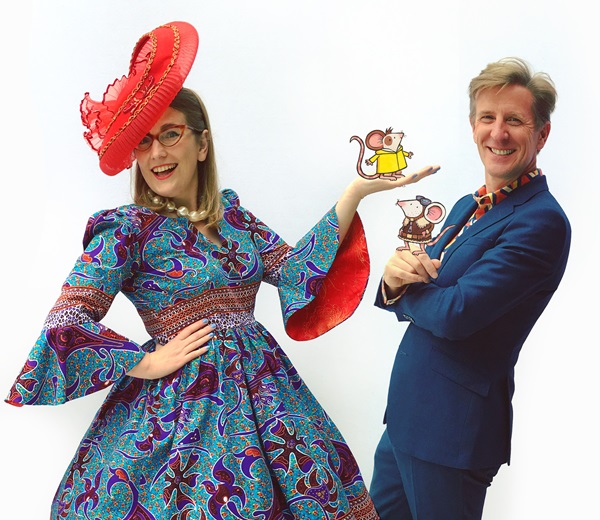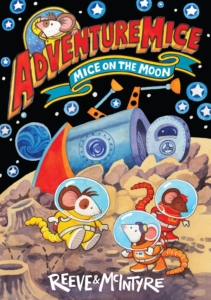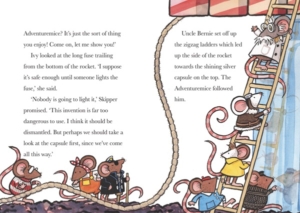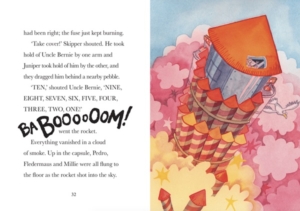
Adventuring with Reeve and McIntyre
Andrea Reece interviews Philip Reeve and Sarah McIntyre about their latest series, AdventureMice.
 Reeve and McIntyre have been a star double act in children’s books now for over a decade, bringing unbridled fun and laughter to young readers. Catching up with them in between author events on World Book Day to talk about their hugely successful creative partnership was just as much fun as you’d expect. It was a conversation in the Green Room of the Edinburgh Book Festival that first brought the two of them together, Sarah telling Philip about her aim to post a drawing on her blog every day. Philip, originally an illustrator, had stopped drawing and thought that was a good idea. Soon they were comparing their daily illustrations and before long had decided they should do a book together.
Reeve and McIntyre have been a star double act in children’s books now for over a decade, bringing unbridled fun and laughter to young readers. Catching up with them in between author events on World Book Day to talk about their hugely successful creative partnership was just as much fun as you’d expect. It was a conversation in the Green Room of the Edinburgh Book Festival that first brought the two of them together, Sarah telling Philip about her aim to post a drawing on her blog every day. Philip, originally an illustrator, had stopped drawing and thought that was a good idea. Soon they were comparing their daily illustrations and before long had decided they should do a book together.
That was twelve books ago – there’s a thirteenth about to go to print and a fourteenth in process, so what do they like about working together? Philip likens it to writing comedy, something he used to do as a student. ‘It was very collaborative – I would write with one or two partners, and the jokes sparked off one another. I don’t know how you’d write a novel collaboratively, but it works really well for this sort of fiction, because it is like writing comedy basically.’
Plus, adds Sarah, ‘It’s really handy to work with Philip because he started out as an illustrator, so he gets it and doesn’t come up with unrealistic designs.’ Philip chips in, ‘And I’d always liked the idea of books that combine text and illustration in interesting ways.’
Both agree that the author tour is much more enjoyable when there’s two of you. Initially that’s when they did most of the writing – in hotels, on trains, in festival green rooms. But now that Sarah and her partner have moved to Devon, ‘just down the road’ from Philip, they can get together much more easily. Walks across Dartmoor are obviously conducive to creative thinking too. ‘We’re always coming up with ideas when we’re out for walks’ says Philip, ‘Silly ideas pop up and some of them stick. We think maybe we could develop that one into a story, start talking about characters and how it would work and come up with the rough outline. I write with Sarah checking in on me, and we do the roughs together usually, and then Sarah does the artwork, which is the big job, especially with AdventureMice which are full colour.’
‘It takes me about two weeks to do pencil roughs by myself’ interjects Sarah, ‘But when Philip comes and sits at the desk with me, we can do it so much faster.’
Like many books of the moment, the AdventureMice books began in lockdown. Sarah had set time aside to do a sabbatical which then got cancelled because of COVID. With a gap in her publishing schedule, and confined to home, she began doing paintings of model ships she’d collected from Deptford Market – ‘for about £3 each!’ – putting little mouse characters on them ‘just to make it fun’. She’d put them on Twitter and people would buy them instantly. ‘I really enjoyed it’ she says, ‘Stuck in lockdown I couldn’t go on adventures so the idea of these tiny mice going on tiny adventures was a lot of fun.’
 Initially she thought about putting the mice in a picture book but felt that more space was needed to tell the story. Even so, the AdventureMice books are shorter than their earlier series; on the advice of their long-time editor Liz Cross, they’re just 6000 words. ‘They have to be very spare,’ says Philip.
Initially she thought about putting the mice in a picture book but felt that more space was needed to tell the story. Even so, the AdventureMice books are shorter than their earlier series; on the advice of their long-time editor Liz Cross, they’re just 6000 words. ‘They have to be very spare,’ says Philip.
The stories of a community of little mice who undertake some big adventures, in the latest a trip to the moon, spare they may be, but they’re still action-packed and full of zest and humour. There’s a real child’s-eye view to the books – Philip likens it to that sense of being down on the floor playing with toys – and the mice display a delightful ingenuity, flying planes and helicopters and even steering a submarine. The pleasure the two have in writing for this age group is clear from start to finish. What do they like best about it? ‘It’s fun because they kids are happy to believe in the world’, says Sarah. ‘They’ll suspend disbelief very easily’ agrees Philip. ‘You don’t have to put props and framework in place to achieve the suspension of disbelief that you do with older readers.’
They’re also happy to be creating books that bridge the gap from picture books to chapter books. ‘Some kids go from picture books straight into books with no pictures, and that’s scary’ says Sarah, ‘You need pictures to anchor you on the page. But you also need text to anchor you. If there’s just an illustration, adults will miss that page altogether. We’ve learned to go back and make sure we always have some words on the page.’
‘Even when Sarah does one of her big lovely double page spreads’ says Philip, ‘We try and make sure there’s a couple of lines of text.’
‘Adults don’t realise the pictures are important to the story’ laughs Sarah, ‘Kids think it’s the only thing!’
As it’s World Book Day, I ask them what they recommend to ensure children are reading for pleasure. ‘Fun,’ says Philip decisively, ‘Actual fun. Children’s books should be entertainment and if children enjoy being entertained by books, they’ll move on to more artistic things later, to serious literature if you like. I’m not saying books have to be funny, but they should be entertaining – that’s how you get people to read for pleasure, you entertain them’.
He’s adamant too that they steer clear of issues in their books. ‘Things have got very Victorian in children’s publishing now, with a lot of books training to you to be a good and responsible citizen. We just want to muck about.’
‘The Adventure Mice are brave little mice’ adds Sarah, ‘They go out and do stuff. We don’t just want kids to read, we want them to read and also go out and do things.’
‘Occasionally you meet a child who reads hundreds and hundreds of books’ adds Philip, ‘And it’s slightly worrying, as worrying as if they were spending all their time on computer games. If someone’s reading to the exclusion of everything else, that’s not a well-balanced childhood.’
‘Yes, don’t give kids books that make them feel guilty all the time’ says Sarah. ‘Make them love the world, then they’ll want to protect it. Don’t just tell them it’s their fault the world is going to pot, they’ll turn into little nihilists.’ ‘Who hate books!’ adds Philip.
Their secret to successful creating books for this age group can be summed up as humour and heart. ‘Well-crafted jokes are a good thing’, says Philip, ‘A well-made joke is funny to 2 year olds and 82 year olds.’ And if you can capture a sense of warmth even when things get tense and dramatic, that’s great’ says Sarah.
As the interview draws to a close, I ask them what they admire most in the other’s writing. ‘Philip has a really good sense of how stories work’ says Sarah, ‘how the structure works. He doesn’t just start with a good premise and then spin it out, even in the last third of a book, he’s still introducing interesting new elements. I love the fact he doesn’t relax until the very end.’
‘Sarah is a very good writer’ says Philip, ‘which people don’t always realise, they think she’s just playing with paint. And her drawings are fantastic and getting better and better, each AdventureMice book is more magnificent. This is the sort of working relationship I always wanted.’
Andrea Reece is managing editor of Books for Keeps.
The AdventureMice books are published by David Fickling Books, £6.99 each.
Adventuremice: Otter Chaos, 978-1788452670
Adventuremice: Mermouse Mystery, 978-1788452687
Adventuremice: Mice on the Ice, 978-1788452694
Adventuremice: Mice on the Moon, 978-1788452700
Be sure to visit the special AdventureMice website, which is full of great activity sheets and more to download.





